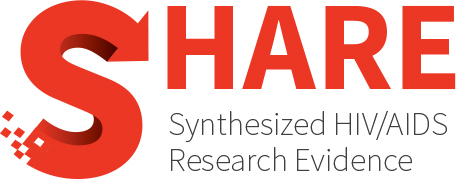Category Archives: Prevention, Engagement and Care Cascade
Integration of female genital schistosomiasis into HIV/sexual and reproductive health and rights and neglected tropical diseases programmes and services: A scoping review
Female genital schistosomiasis (FGS) affects approximately 56 million women and girls across sub-Saharan Africa and is associated with up to a threefold increased prevalence of HIV. Integrating FGS with HIV...
Potentially inappropriate prescribing in older people living with HIV: A scoping review
BACKGROUND: Antiretroviral therapy has transformed HIV from a progressive and often fatal infection to a chronic disease. Currently, people living with HIV (PLHIV) have near-normal life expectancy; however, they face...
Tenofovir-induced renal dysfunction among HIV-infected patients: A systematic review
Tenofovir disoproxil fumarate (TDF) is an antiretroviral drug widely used as part of antiretroviral therapy (ART) to treat human immunodeficiency virus (HIV-1) infection. Negative effects of tenofovir include impaired kidney...
Prevalence of delayed antiretroviral therapy initiation among people living with HIV: A systematic review and meta-analysis
Objective HIV continues to be a global challenge. Key recommendations for HIV prevention and treatment are presented on rapid antiretroviral therapy (ART) initiation. However, several studies showed a high prevalence...
Immunogenicity and effectiveness of COVID-19 booster vaccination among people living with HIV: A systematic review and meta-analysis
Background The effect of booster vaccinations with the coronavirus virus disease (COVID-19) vaccine on people living with HIV (PLWH) remains unknown. In this study, we aimed to investigate the immunogenicity...
Clinical relevance of drug interactions in people living with human immunodeficiency virus on antiretroviral therapy—Update 2022: Systematic review
BACKGROUND: The clinical outcomes of antiretroviral drugs may be modified through drug interactions; thus, it is important to update the drug interactions in people living with HIV (PLHIV). AIM: To...
Systematic review on cumulative HIV viraemia among people living with HIV receiving antiretroviral treatment and its association with mortality and morbidity
BACKGROUND: We performed a systematic review to generate evidence on the association between cumulative human immunodeficiency virus (HIV) viraemia and health outcomes. METHODS: Quantitative studies reporting on HIV cumulative viraemia...
The prognosis of progressive multifocal leukoencephalopathy in HIV/AIDS patients undergoing highly active antiretroviral treatment: A systematic review
Progressive multifocal leukoencephalopathy (PML), a viral infection of the central nervous system (CNS), is most commonly associated with advanced HIV infection. Although the severe neurological conditions—PML and progressive multifocal leukoencephalopathy...
Understanding the role of religious beliefs in adherence to antiretroviral therapy among Pentecostal Christians living with HIV in sub-Saharan Africa: A scoping review
Background Optimum adherence to antiretroviral therapy (ART) is crucial in managing HIV. However, some people’s religious beliefs can influence how they deal with HIV and the psychosocial factors influencing their adherence...
